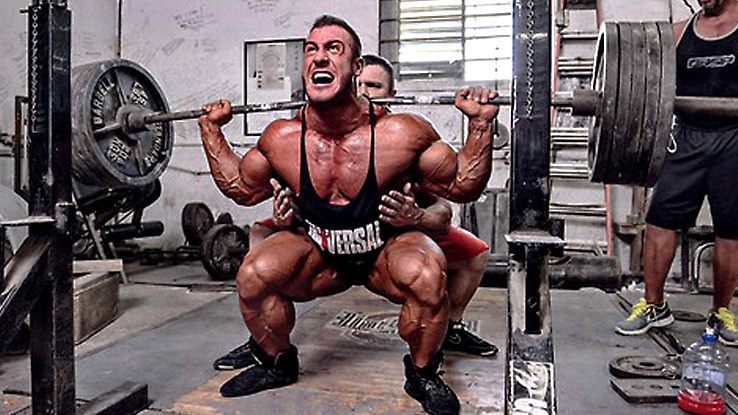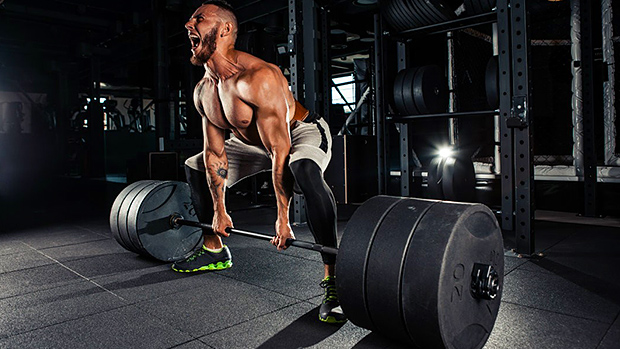Here's what you need to know...
- Some people take the depth issue too far. No one cares how deep you can get if you're squatting with a toothpick and two olives.
- Most people can't squat deep because of one of three problems – lack of mobility, lack of technique, or lack of stability. Regardless, going ass-to-grass isn't really necessary.
- Technique first and range of motion second! Remember, there are no style points for going lower in a meet. Hit your depth and come up!
A squat is a squat. It's not a "back squat." There's no such thing as an Olympic squat. The only squat contested in a sanctioned competition is one with a bar on your back where the lifter goes low enough so the crease of the hip is below the knee. Any other squat variation is simply a means to bring up your competition-style squat. No one cares how deep you can get if you're squatting with a toothpick and two olives.
Squat slightly below parallel and stand up if you want to get big and strong! This will allow you to use the most amount of weight possible through a great range of motion while stimulating the most amount of muscle in your entire body. But that brings us to the real question: Is going deeper really any better?
Squatting deep is fine, but the truth is most people can't handle ultra low squats right away. Listen, I'm not telling you to squat high as a kite. Squat depth has meant a lot to me even when I was a young buck in high school. My senior quote was, "Friends don't let friends squat high." But the truth is, some people take the whole depth issue way too far.
I used to squat extra deep just because I thought it was the bees knees. I would end up in a good morning position with my hips way back on the way up, which ended up leading to a host of lower back issues. Now I keep better form and squat just below parallel. Like most things, the answer of how deep should you go lies somewhere in the middle. The problem with 99% of the population squatting deep enough is that most are lacking one, two, or all of three things.
Many guys are initially too immobile to squat way past parallel. Part of this problem is due to modern society. Most chairs are at a height that approximates an above parallel squat. Most people also sit slumped over; the hips flexors get short and you're essentially training your body to stop in a crappy high squat. Even most toilets are set above parallel. They actually have "squatty potties" that you can buy to put under your feet so you can defecate in a more natural, below-parallel squat position. Back in the day everyone HAD to squat below parallel just to go to the bathroom! So all of you Paleo freaks out there should make sure you aren't just eating and training like a caveman, but also shitting like one too!
It's imperative you perform soft tissue work on your entire lower body as well as mobilize the ankles, hips, and thoracic spine. As part of your squat warm up, make sure to mobilize both your ankles for dorsiflexion and your T-spine for extension. Here's a great series to mobilize the ankles before squatting:
And here's my favorite hip opening sequence that I use before I squat:
To improve t-spine extensions before doing any barbell lift, I use the old double-tennis ball gizmo and then progress to a double lacrosse ball number. Remember to focus on the upper back and not the lower back or neck.
So next time you try to squat ass to ankles or better yet, yam bag to the floor, remember only go as low as you can control and maintain proper form. Technique first and range of motion second! Remember, there are no style points for going lower in a meet. Hit your depth and come up!
When we teach the set-up for the squat, we focus on three main things: placement of feet, bar placement, and hand placement. In general, a wider or thicker person can carry the bar lower, have their hands wider, and have a wider stance, but again this varies. We have many people that squat narrow and many that squat wide at our gym. Eleven of our lifters are national ranked and they're all different weight classes and body types. They each have their own squatting style, but certain things hold true for everyone.
Bar Placement
The bar should rest somewhere between the traps and rear delts. Bring the bar too low and the lifter will pitch forward. The same thing happens when you bring the bar too high. In general, a lower bar placement forces the lifter into a more hip dominant movement so there'll be more range of motion in the hips and the chest will move forward while the back will remain straight. A higher bar position will typically allow the lifter to stay more upright and likewise squat more straight down with the knees coming more forward.
Feet Placement
The big person with wider hips and a big belly will have to go wider to give himself room to get down. A person with more narrow hips should generally squat close. If you go so wide that you can't get your knees out to where your ankles are, you're too wide. If you go so wide or so close you can't hit depth, you need to adjust your stance.
In general, a wide stance squatter will do better with a flat shoe like Chucks or Mark Bell's squat shoe. A medium stance squatter would do well with something with a moderate heel like an Adidas Samba (Chad Smith and Eric Lillibridge both squatted over 900 in these), and a narrow stance squatter will do better with heeled weightlifting shoes to accommodate the knees coming more forward. Regardless of squatting style, make sure to screw your feet into the ground to create tension and stability in your hips at the start of the lift.
Hand Placement
This is going to ultimately depend on mobility. A bigger, stiffer guy will usually have to go wider. That being said, I saw Malan squat a WR 1014 at Raw Unity with a very close hand placement while weighing 330, so if you have the mobility to keep your hands close, by all means do it. Just keep in mind you're going to be benching and deadlifting later in the week, so you don't want to go so close you aggravate your biceps tendon.
Go as close as you can as this will get your back tighter, but not so close it hurts your shoulders. A good tip for people with tight shoulders is to take a pinky off the bar. Besides keeping it classy, it allows the lifter to rotate his arms under the bar and keep the shoulder in a better position.
If, despite knowledge of proper form, you still face technique problems with the chest falling forward, the knees coming in, or an incorrect body position in the hole, here are 3 drills you can use to fix them.
Chest falling forward
Fix: Wall squats. Squat directly facing a wall. This will force you to keep your chest up and hips back.
Knees coming in
Fix: Squats with band around knees. The band around your knees will force your knees inward so you must actively push the band apart to get your knees out.
Body position in the bottom
Fix: Pause squats. Pause squats are great for finding your strongest and most stable bottom position as well as developing strength out of the hole. Try 3-5 second pauses to really hone in your form.
Most people have absolutely no control over their body when they first learn to squat. They drop down into the hole with all the tightness of a fish flopping around on a dock. The key to maintaining proper form is harnessing stability through tension. Remember that more tension equals more strength. Creating tension is the key for maintaining proper form during the execution of the lift.
You want to have tension in three key areas: the hips, the trunk, and the upper back. Because of this it's a good idea to warm up the glutes, abs, and upper back with activation exercises before you squat. The key is doing enough to stimulate the muscle, but not enough to fatigue it. Do just enough to get blood flow and feel the appropriate muscle groups "turn on." This will help prime the body to use this muscle for stability later in the workout. These activation exercises, done as part of your warm up, can also be used for longer durations or more reps as accessory movements later in the workout.
Hips
Do band side steps (placing a band around the knees and walking laterally while maintaining tension on the band) or seated abduction. Any movement that promotes abduction and or external rotation will help get the outer hips and glutes going for the session to come! These exercises made a profound difference in allowing me to get my knees out, especially in the hole. I even saw some of the best lifters in the world warm up with band hip circles, so this stuff works at all levels.
Trunk
Do any type of plank variation. Focus on belly breathing and creating tension throughout the entire trunk. A good cue is to breathe into your lower back. That will ensure you're getting stability and tension in all directions, not just in the front. You want to actively use your diaphragm to push into your belt from all angles. This creates intra abdominal pressure and will keep your lower back and pelvis stable throughout the entire lift.
Upper Back
Any type of pulldown movement or band pull apart will work. During the squat it's important to be able to hold the lats and rear delts in a static position, so make sure you add in some pauses or even do a long isometric hold to help train your back to contract statically for a long period of time. Behind the neck pulldowns with a pause is a good exercise that closely mimics the position you'd squat in. Here's a good drill to learn lat tension:
- Mobility Work: Ankles, hips, t-spine
- Activation: Hips, trunk, upper back
- Primary Exercise: Squats. Hit them hard and heavy.
- Supplemental Movement: Front squats, pause squats, and/or Anderson squats would be good choices here.
- Accessory Movements: Any muscle group involved in the squat; think in bodybuilding terms – hamstrings, quads, hips, glutes, abs, backs, etc.
Squatting deep is cool, but what's even cooler is squatting properly. If you're dead set on squatting ass-to-grass, that's fine, but make sure you're doing the necessary work to do it right. Include both mobility and stability work specific to the squat as well as hammering your technique. And, if you're a competitive lifter, remember that there aren't any style points for going deeper!




